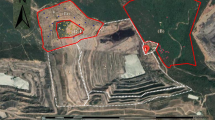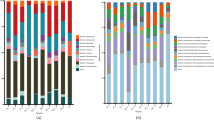Abstract
Termites inhabit tropical and subtropical areas where they contribute to structure and composition of soils by efficiently degrading biomass with aid of resident gut microbiota. In this study, culture-independent molecular analysis was performed based on bacterial and archaeal 16S rRNA clone libraries to describe the gut microbial communities within Cornitermes cumulans, a South American litter-feeding termite. Our data reveal extensive bacterial diversity, mainly composed of organisms from the phyla Spirochaetes, Bacteroidetes, Firmicutes, Actinobacteria, and Fibrobacteres. In contrast, a low diversity of archaeal 16S rRNA sequences was found, comprising mainly members of the Crenarchaeota phylum. The diversity of archaeal methanogens was further analyzed by sequencing clones from a library for the mcrA gene, which encodes the enzyme methyl coenzyme reductase, responsible for catalyzing the last step in methane production, methane being an important greenhouse gas. The mcrA sequences were diverse and divided phylogenetically into three clades related to uncultured environmental archaea and methanogens found in different termite species. C. cumulans is a litter-feeding, mound-building termite considered a keystone species in natural ecosystems and also a pest in agriculture. Here, we describe the archaeal and bacterial communities within this termite, revealing for the first time its intriguing microbiota.





Similar content being viewed by others
References
Holt JA, Lepage M (2000) Termites and soil properties. In: Abe T, Bignell DE, Higashi M (eds) Termites: evolution, sociality, symbioses, ecology. Kluwer, Dordrecht, pp 389–407
Engel M, Grimaldi D, Krishna K (2009) Termites (Isoptera): their phylogeny, classification, and rise to ecological dominance. Am Mus Novit 3650:1–27
Ohkuma M (2003) Termite symbiotic system: efficient bio-recycling of lignocellulose. Appl Microbiol Biotechnol 61:1–9
Hackstein JHP, Stumm CK (1994) Methane production in terrestrial arthropods. Proc Natl Acad Sci U S A 91:5441–5445
Sanderson MG (1996) Biomass of termites and their emissions of methane and carbon dioxide: a global database. Global Biogeochem Cycles 10:543–557
Hongoh Y, Ohkuma M, Kudo T (2003) Molecular analysis of bacterial microbiota in the gut of the termite Reticulitermes speratus (Isoptera; Rhinotermitidae). FEMS Microbiol Ecol 44:231–242
Warnecke F, Luginbühl P, Ivanova N et al (2007) Metagenomic and functional analysis of hindgut microbiota of a wood-feeding higher termite. Nature 450:560–565
Breznak JA, Brune A (1994) Role of microorganisms in the digestion of lignocellulose by termite. Annu Rev Entomol 39:453–487
Redford K (1984) The termitaria of Cornitermes cumulans (Isoptera, Termitidae) and their role in determining a potential keystone species. Biotropica 16:112–119
Constantino R (2002) The pest termites of South America: taxonomy, distribution and status. J Appl Entomol 126:355–365
Turque AS, Batista D, Silveira CB et al (2010) Environmental shaping of sponge-associated archaeal communities. PLoS One 5:e15774
Luton PE, Wayne JM, Sharp RJ et al (2002) The mcrA gene as an alternative to 16S rRNA in the phylogenetic analysis of methanogen populations in landfill. Microbiology 148:3521–3530
Ashelford KE, Chuzhanova NA, Fry JC et al (2006) New screening software shows that most recent large 16S rRNA gene clone libraries contain chimeras. Appl Environ Microbiol 72:5734–5741
Thompson JD, Gibson TJ, Plewniak F et al (1997) The ClustalX windows interface: flexible strategies for multiple sequence alignment aided by quality analysis tools. Nucleic Acids Res 24:4876–4882
Schloss PD, Westcott SL, Ryabin T et al (2009) Introducing mothur: open-source, platform-independent, community-supported software for describing and comparing microbial communities. Appl Environ Microbiol 75:7537–7541
Tamura K, Peterson D, Peterson N et al (2011) MEGA5: molecular evolutionary genetics analysis using maximum likelihood, evolutionary distance, and maximum parsimony methods. Mol Biol Evol 28:2731–2739
Breznak JA (2000) Ecology of prokaryotic microbes in the guts of woodland litter-feeding termites. In: Abe T, Higashi M, Bignell D (eds) Termites: evolution, sociality, symbiosis, ecology. Kluwer, Dordrecht, pp 209–232
Brauman A, Dore J, Eggleton P et al (2001) Molecular phylogenetic profiling of prokaryotic communities in guts of termites with different feeding habits. FEMS Microbiol Ecol 35:27–36
Hongoh Y (2011) Toward the functional analysis of uncultivable, symbiotic microorganisms in the termite gut. Cell Mol Life Sci 68:1311–1325
Brune A, Emerson D, Breznack JA (1995) The termite gut microflora as an oxygen sink: microelectrode determination of oxygen and pH gradient in guts of lower and higher termites. Appl Environ Microbiol 61:2681–2687
Wang Q, Garrity GM, Tiedje J, Cole JR (2007) Naive Bayesian classifier for rapid assignment of rRNA sequences into the new bacterial taxonomy. Appl Environ Microbiol 73:5261–5267
Hongoh Y, Deevong P, Inoue T et al (2005) Intra- and interspecific comparisons of bacterial diversity and community structure support coevolution of gut microbiota and termite host. Appl Environ Microbiol 71:6590–6599
Nakajima H, Hongoh Y, Usami R et al (2005) Spatial distribution of bacterial phylotypes in the gut of the termite Reticulitermes speratus and the bacterial community colonizing the gut epithelium. FEMS Microbiol Ecol 54:247–255
Graber JR, Leadbetter JR, Breznak JA (2004) Description of Treponema azotonutricium sp. nov. and Treponema primitia sp. nov., the first Spirochetes isolated from termite guts. Appl Environ Microbiol 70:1315–1320
Noda S, Hongoh Y, Sato T et al (2009) Complex coevolutionary history of symbiotic Bacteroidales bacteria of various protists in the gut of termites. BMC Evol Biol 9:158
McDonald D, Price MN, Goodrich J et al (2012) An improved Greengenes taxonomy with explicit ranks for ecological and evolutionary analyses of bacteria and archaea. ISME J 6:610–618
Dorador C, Vila I, Remonsellez F et al (2010) Unique clusters of Archaea in Salar de Huasco, an athalassohaline evaporitic basin of the Chilean Altiplano. FEMS Microbiol Ecol 73:291–302
Chin K, Lukow T, Stubner S et al (1999) Structure and function of the methanogenic archaeal community in stable cellulose-degrading enrichment cultures at two different temperatures (15 and 30 degrees C). FEMS Microbiol Ecol 30:313–326
Friedrich MW, Schmitt-Wagner D, Lueders T et al (2001) Axial differences in community structure of Crenarchaeota and Euryarchaeota in the highly compartmentalized gut of the soil-feeding termite Cubitermes orthognathus. Appl Environ Microbiol 67:4880–4890
Brune A, Ohkuma O (2011) Role of the termite gut microbiota in symbiotic digestion. In: Bignell DE, Roisin Y, Lo N (eds) Biology of termites: a modern synthesis. Springer, Dordrecht, pp 439–475
Purdy KJ (2007) The distribution and diversity of Euryarchaeota in termite guts. Adv Appl Microbiol 62:63–80
Leadbetter JR, Breznak JA (1996) Physiological ecology of Methanobrevibacter cuticularis sp. nov. and Methanobrevibacter curvatus sp. nov., isolated from the hindgut of the termite Reticulitermes flavipes. Appl Environ Microbiol 62:3620–3631
Leadbetter JR, Crosby LD, Breznak JA (1998) Methanobrevibacter filiformis sp. nov., a filamentous methanogen from termite hindguts. Arch Microbiol 169:287–292
Odelson DA, Breznak JA (1985) Cellulase and other polymer-hydrolyzing activities of Trichomitopsis termopsidis, a symbiotic protozoan from termites. Appl Environ Microbiol 49:622–626
Acknowledgments
This work was supported by Petrobras (CENPES), FAPERJ, and CNPq. The authors are grateful to Dr. Martha Sorenson for the revision of the manuscript. We acknowledge the services of the Johanna Döbereiner Genome Sequencing facilities (IBqM/UFRJ). We thank Joyce Lima, Catia Chaia, and Denise Oliveira for library construction, sequencing, and technical assistance.
Author information
Authors and Affiliations
Corresponding author
Electronic supplementary material
Below is the link to the electronic supplementary material.
ESM 1
(PDF 143 kb)
Rights and permissions
About this article
Cite this article
Grieco, M.A.B., Cavalcante, J.J.V., Cardoso, A.M. et al. Microbial Community Diversity in the Gut of the South American Termite Cornitermes cumulans (Isoptera: Termitidae). Microb Ecol 65, 197–204 (2013). https://doi.org/10.1007/s00248-012-0119-6
Received:
Accepted:
Published:
Issue Date:
DOI: https://doi.org/10.1007/s00248-012-0119-6




